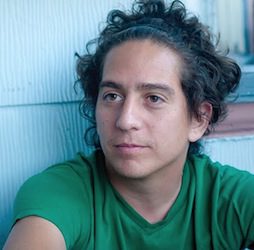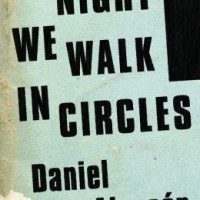In his stellar debut collection War By Candlelight, Daniel Alarcón won no shortage of acclaim for his floating world of young drifters perpetually stuck between the Lima they remembered and the America to which they had immigrated. His big-hearted, melancholy characters were people we knew, traversing the bridge between adolescence and adulthood, obsessed with lost things—memories, loves, and innocence. In his first novel Lost City Radio, Alarcón elevated his themes beyond the naturalistic. The fatigued beauty of Lima grew into an unnamed, dystopic South American nation where a totalitarian regime aimed to wipe the memories of a brutal civil war from the minds of its citizens.
Alarcón’s new novel, At Night We Walk in Circles, continues the author’s drive down the avenida between allegory and naturalism. Like Lost City Radio, At Night We Walk in Circles erects hefty allegorical signposts. The setting is again an unnamed stand-in for Peru bearing a massive prison ominously named Collectors. A theater troupe named Diciembre revives a protest play named The Idiot President, the content of which landed its playwright Henry Nuñez in Collectors for two decades. The characters are all still struggling to move forward in the aftermath of Peru’s decades-long civil war between the government and guerilla groups. Alarcón’s fluid, self-assured prose is narrated by a young man chronicling the events that led to the unfortunate fate of Nelson, the young lead actor in the play. Did the moody, demanding Henry, scarred by his years in Collectors, push Nelson too far during the production? And what’s the relationship between Nelson and the narrator, who, like Gatsby’s Nick Carraway, is a bit player in the book’s events? This passage explains why the narrator is so obsessed with Nelson’s fate—as one of the many lost youth in South America, the narrator believes his life is linked to Nelson’s:
I compared this image with others I’d seen, with my own fragmented recollection of our one encounter, at the end of June the previous year; and suddenly, I had the strangest sensation, like double vision. For just an instant, I thought I saw myself standing just to the side of Francisco and Nelson, with another family—mine—and another set of siblings—my two sisters. An unlikely, but not impossible, coincidence. I stared at the image.
I also grew up in this city.
I was also once a brown-haired boy with thin legs and a bony chest.
I also went to the zoo. We all did.
It wasn’t me hovering in the background of that old photograph, of course, but that’s not the point. It could’ve been.

At Night We Walk in Circles aims to do it all. It aims to elevate Henry’s quest to take his production into the rural villages into a metaphysical one that salves the country’s painful past. It aims to create a compelling character mystery that is emblematic of the struggle of the nation’s youth in a land that has yet to provide opportunity and hope for a more prosperous future. During Diciembre’s tour into the highlands and lowlands of the Andes, Alarcón succeeds in merging the allegory and the developments of his characters.
The descriptions of indigent villages sparkle as the narrator illustrates the effects of the country’s systematic imprisonment of young men, while crystallizing why Henry is so driven to perform in the final village on the tour. His lover in Collectors came of age there.
Every building, with the exception of the municipal offices, needed a new coat of paint. The town was surrounded on all sides by yellow-green hills that seemed almost lush for this altitude, hills which were themselves dwarfed by jagged snowcapped peaks…Like many settlements one comes across in the highlands, T—— was a village without men. Nelson, age twenty-three, Patalarga, forty, Henry, forty-six—Diciembre had essentially no contemporaries. I feel the same absence whenever I visit. There were children; there were elderly; and there were a handful of adolescent boys, who were in many ways, a species apart: restless, unpleasant, wearing expressions Henry recognized from his past. ‘They were like inmates hatching escape plans,’ he told me. Rogelio had been one of them—that much was clear to Henry the moment he stepped off the bus from San Jacinto and saw the boys waiting in the plaza. They had a hunger in them, the same desire that had sent Rogelio to the city, pushing him along the accidental and luckless path that ended at Collectors prison, when he was only twenty-one.
By the second half of the book, the allegory and the developments that lead to Nelson’s downfall split into thoroughfares with distinct destinations, leaving one to wonder: what is At Night We Walk in Circles really getting at? Henry’s tour ends up having surprisingly little consequence to Nelson or the country Alarcón has created. Nelson’s lead performance is less relevant to his fate than a love triangle that precedes the tour. A cipher throughout the book, Nelson is not nearly as fascinating as the characters and events orbiting him. I wished that he was more political, an idealistic foil to Henry’s damaged motivations. The connection between the narrator and Nelson also remains abstract until the book’s final pages, which hastily cleans up some of the split ends of the book’s third act.
Despite the many metafictional conceits that seem to signal a more panoramic ambition, the strongest scenes in At Night We Walk in Circles are the domestic ones. Alarcón’s eye is sharpest in the rooms of his characters, where we feel most the memories, loves, and innocence lost in the civil war.
If Nelson had known more about T——, known more about the region and the relentless out-migration that had changed it, he’d have known that all the houses in town had rooms like this. That some houses, in fact, were nothing but large, sprawling versions of this room, no living space left, no people, only assorted objects gathering dust behind padlocked doors. He might have appreciated that Mrs. Anabel and Noelia had managed to contain the past, more or less; that by holding it within the four walls of the boys’ old room, they were living, to a greater degree than many of the neighbors, in the present.
At Night We Walk in Circles is a page-turning, satisfying read by a confident purveyor of prose, but it narrowly misses its lofty ambitions when Diciembre, Nelson, and Alarcón’s allegorical Peru stop traveling in the same circles.




